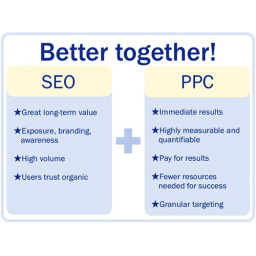Optimizing User Experience
by Abbs
Posted on 2023-05-18 08:01:07

Improving User Experience
In addition to having relevant and premium content, user experience is likewise an important factor in SEO. A website that provides an excellent user experience tends to rank higher on online search engine result pages (SERPs) compared to a website with a poor user experience. In this chapter, we'll check out ways to improve user experience on your website and enhance your SEO.
Comprehending User Experience
User experience (UX) refers to how users interact with your website. It involves how easy it is for users to browse your site, discover the information they require, and complete jobs such as submitting a contact type or making a purchase. An excellent user experience supplies a smooth and instinctive experience that meets the needs of the user.
TIP:Socialize your content! Encourage social sharing to increase visibility and drive more traffic.
To improve user experience on your website, you need to understand your audience and their requirements. Performing user research, such as studies or focus groups, can help you collect valuable insights on how users communicate with your site and what they discover aggravating. This information can assist your efforts to improve user experience on your site.
Website Design and Navigation
Website style and navigation are crucial aspects of user experience. Your website must be visually enticing and simple to navigate. Here are some tips to improve website style and navigation:
- Keep the design basic and tidy: Avoid cluttering the site with too many aspects, which can make it hard for users to discover what they're looking for.
- Use intuitive navigation: Make certain the navigation menu is simple to discover and utilize. Usage clear and descriptive labels for each menu item.
- Execute a search bar: A search bar can assist users rapidly discover the content they're searching for.
- Optimize for mobile: More and more users are accessing websites on their mobile devices, so ensure your website is optimized for mobile devices.
Website Speed
Website speed is another important aspect of user experience. Slow-loading websites can frustrate users and lead them to desert your site. Moreover, page speed is a ranking consider Google's algorithm. Therefore, it's important to optimize your website for speed. Here are some tips:

- Lessen HTTP demands: Lower the number of requests by reducing the number of aspects on a page, combining several style sheets, and minimizing the number of scripts.
- Optimize images: Utilize compressed and properly formatted images to decrease the size of the page.
- Usage browser caching: Caching allows browsers to store specific parts of your website so that it can load quicker on subsequent gos to.
- Utilize a content delivery network (CDN): A CDN can improve website speed by caching your website's content on servers found all over the world.
Content
Finally, the content on your website plays a substantial role in user experience. High-quality and relevant content keeps users engaged and motivates them to explore your site further. Here are some tips for improving the content on your site:
- Use headings and subheadings: Headings and subheadings make it much easier for users to scan content and discover the information they're looking for.
- Use images and videos: Images and videos can make your content more engaging and improve user experience.
- Break up big blocks of text: Big blocks of text can be overwhelming and discourage users from reading. Use much shorter paragraphs and bulleted lists to break up text.
- Use clear and succinct language: Usage language that is easy to understand and avoid jargon or technical terms that might confuse users.
Structured Data Markup
Structured data markup is a method of including metadata to your website's code to provide more information to online search engine about your content. This information is used to improve search engine result by supplying more comprehensive information to the user.
Structured data markup utilizes a specific format called schema.org, which supplies a standard vocabulary for describing the content of web pages. This vocabulary includes various classifications such as organizations, events, items, and evaluations.
The benefits of using structured data markup include improved visibility in search engine results, higher click-through rates, and improved online search engine rankings. By supplying more in-depth information about your content, search engines are better able to understand the context of your website, leading to higher-quality search results.
TIP:Mobile-first is the way to go! Ensure your website is fully responsive and mobile-friendly.
Structured data markup can be added to your website in numerous ways, including by hand including code to your HTML, utilizing plugins, or utilizing Google's Structured Data Markup Assistant. It is necessary to ensure that your structured data is accurate and current, as mistakes can adversely impact your search engine rankings.
When utilizing structured data markup, it is vital to follow best practices to ensure that your data stands and correctly formatted. This consists of utilizing the correct schema.org vocabulary for your content, avoiding replicate content, and making sure that your markup is executed properly.
Leveraging Social Network for SEO
Social media has actually ended up being a vital part of our daily lives. It has actually changed the method we communicate, interact and share information. Social network has actually also revolutionized the way organizations run, supplying an effective method to reach clients and engage with them. In this chapter, we will discuss how you can take advantage of social networks for SEO.
Why is Social Media Important for SEO?
Social network can have a significant influence on your search engine rankings. While social networks signals do not straight impact search engine rankings, they indirectly affect them. Here are a couple of methods social media can impact your SEO efforts:
-
Increase brand name awareness: Social network can help you increase your brand name's visibility and bring in new clients to your website.
-
Construct links: Social network can assist you build high-quality backlinks to your site, which can improve your online search engine rankings.
-
Boost engagement: Social media can assist you engage with your audience, construct relationships, and motivate them to share your content, which can increase your website's visibility and drive traffic.
-
Create social signals: Social media shares, likes, and remarks can create social signals that can show to search engines that your content is valuable and relevant.
-
Drive traffic: Social network can drive traffic to your site, which can increase your site's authority and online search engine rankings.
How to Utilize Social Media for SEO
To utilize social media for SEO, you require to follow these finest practices:
1. Pick the Right Platforms
There are a number of social networks platforms offered, and you require to select the ones that are most relevant to your business. Concentrate on platforms where your target audience invests the most time. For example, if your target market is young adults, you may wish to concentrate on platforms like Instagram and TikTok. On the other hand, if your target market is professionals, you may want to focus on LinkedIn.
2. Optimize Your Social Network Profiles
Your social networks profiles are an extension of your brand name, and you require to optimize them to make them more noticeable to online search engine. Use relevant keywords in your profile description and ensure that your profile is complete and updated.
3. Share High-Quality Content
To attract and engage your audience on social media, you need to share top quality content. Focus on creating content that is valuable, informative, and relevant to your target market. Usage multimedia such as images, videos, and infographics to make your content more engaging.
TIP:Don't bury the treasure! Optimize your site architecture for easy navigation and better user experience.
4. Motivate Social Sharing
Motivate your audience to share your content on social media. Add social sharing buttons to your website and post to make it easier for your audience to share your content.
5. Engage with Your Audience
Engage with your audience on social networks. React to their comments, answer their questions, and thank them for their support. Building relationships with your audience can help you create a devoted following and increase engagement.
6. Monitor Your Social Media Analytics
Monitor your social media analytics to track your performance and identify locations for improvement. Usage tools like Google Analytics and Hootsuite to determine your social media performance and optimize your social networks strategy appropriately.
Creating a Content Marketing Strategy
Content marketing has become an essential part of modern-day SEO, as it helps services to drive traffic to their website, build their brand, and create leads. Content marketing involves creating and dispersing valuable, relevant, and consistent content to attract and retain a clearly defined audience, eventually driving profitable client action.

To create a successful content marketing strategy, it is important to understand your audience, identify their requirements and interests, and create content that resonates with them. In this chapter, we will explore the key steps associated with creating a content marketing strategy that can assist you achieve your business goals.
Step 1: Define Your Objectives
The first step in creating a content marketing strategy is to specify your goals. This involves identifying what you want to accomplish through your content marketing efforts. Typical content marketing goals include increasing website traffic, generating leads, building brand awareness, improving consumer engagement, and boosting your website's SEO.
Action 2: Identify Your Target Market
As soon as you have actually specified your goals, the next action is to identify your target audience. This involves understanding who your perfect client is, what their requirements and interests are, and how your service or products can meet their needs.
Action 3: Develop Your Content Strategy
After determining your target market, the next step is to develop your content strategy. This involves creating a prepare for the type of content you will produce, the topics you will cover, and the channels you will use to distribute your content. Your content strategy need to line up with your business goals and deal with the requirements and interests of your target market.
TIP:Snatch the featured snippet! Optimize your content to appear as a rich snippet on search results.
Step 4: Create High-Quality Content
Creating top quality content is essential to the success of your content marketing strategy. This involves producing content that is engaging, informative, and valuable to your target audience. Your content needs to be optimized for SEO, and it should include a clear call-to-action that motivates your audience to take the preferred action.
Step 5: Promote Your Content
Promoting your content is crucial to guaranteeing that it reaches your target market. This involves using a range of channels to distribute your content, including social networks, e-mail marketing, and influencer outreach. You can also consider paid advertising alternatives, such as Google Ads or social media advertisements, to additional promote your content.
Step 6: Measure and Examine Your Results
The final step in creating a successful content marketing strategy is to determine and evaluate your results. This includes tracking your website traffic, engagement metrics, and conversion rates to assess the effectiveness of your content marketing efforts. Based upon your analysis, you can adjust your strategy to optimize your results.
In conclusion, creating a successful content marketing strategy needs careful preparation, a deep understanding of your target market, and the capability to produce high-quality content that resonates with your audience. By following the actions described in this chapter, you can create a content marketing strategy that drives traffic, builds your brand name, and generates leads for your business.
Conclusion
Social network can be an effective tool to improve your SEO efforts. By leveraging social networks, you can increase your brand awareness, develop premium backlinks, increase engagement, generate social signals, and drive traffic to your website. Follow these best practices to make the most of social media for SEO and take your digital marketing efforts to the next level.
TIP:Beat the bounce! Optimize your website for lower bounce rates with engaging content and intuitive design.
Improving user experience on your website is critical for enhancing your SEO efforts. By understanding your audience, optimizing website design and navigation, enhancing website speed, and creating top quality content, you can provide a smooth and intuitive experience that satisfies the needs of your users. By doing so, you'll not only improve your rankings on SERPs, however likewise increase engagement and conversions on your website.
In conclusion, structured data markup is an essential tool for enhancing your website's visibility in online search engine results. By offering more comprehensive information about your content, you can improve your website's online search engine rankings, resulting in higher-quality search results page and increased traffic to your website.
 What Are Long-Tail Keywords and Why Should You Utilize Them?
In the ever-evolving world of Seo (SEO
What Are Long-Tail Keywords and Why Should You Utilize Them?
In the ever-evolving world of Seo (SEO
 Making Use Of Paid Advertising for SEO
While organic search traffic is essential for any website, i
Making Use Of Paid Advertising for SEO
While organic search traffic is essential for any website, i
 Using Influencer Marketing for SEO
Influencer marketing has actually become a popular strategy for
Using Influencer Marketing for SEO
Influencer marketing has actually become a popular strategy for


